Read More |
Searching for systems: Understanding Three HorizonsAndrew Curry, Association of Professional Futurists
"The first thing to say is that the Three Horizons is, at heart, a systems model. ...One of the important characteristics of Three Horizons, therefore, is that the horizons are not just lines; they are each a system. And a little more: they are systems with varying degrees of fitness for the existing landscape. So Horizon One has a present high degree of fitness in the landscape. This includes its underlying assumptions, its institutional arrangements, its infrastructure, its assemblages of actors, its flows of materials, and so on. However, because all systems lose their fitness over time, unless they change, Horizon One becomes less fit for purpose as time goes by. Horizon Three, in the present moment, is not fit for purpose. It is merely a collection of potential: potential flows, potential actors, potential infrastructure, potential institutions, potential paradigms and potential value sets. These are essentially fragments of potential change, representing multiple possible future configurations, or none. As Wiebe Bijker reminds us, in the early stages of an emerging technology (and we can take this to include social technologies) there is considerable ‘interpretative flexibility' between different groups about an emerging technology. A dominant interpretation “is gradually constructed in the social interventions between and within relevant social groups.” The route to Horizon Three from the present is one of alliances and alignments, but also one in which some proposed futures disappear from the discourse. And some H3 ideas remain in hibernation for decades, waiting for the right moment. The Citizen’s Income or Basic Income, now at the edge of the mainstream, was proposed by H.G.Wells almost a century ago. So: in the Third Horizon, we see a set of possible configurations waiting to happen, a set of emergent properties waiting for the right conditions. It is a possible future that for some system actors is also a preferred future. But in its purest sense, the Third Horizon should represent a space where a complete system transformation is proposed. This has implications for the time horizon: for some systems this takes more time than others. This is why the area of the Second Horizon becomes critical. Yes, it represents a transition, but it also a space of conflict between different models of the future. At any one time there are multiple competing Third Horizons, and multiple Third Horizon advocates, competing for the future." Read the rest of this article on Three Horizons thinking by Andrew Curry (published in The Association of Professional Futurists' Compass Newsletter). |
The Case Studies
Read more:
|

